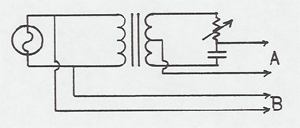A.2.10 Acoustical Interference
Two speakers are set a meter or two apart in front of the class. They are driven by an audio oscillator through a stereo amplifier at the same frequency, but the phase of one channel is variable with respect to the other, either using the circuit below, or the two fundamental channels of the Fourier synthesizer, Z.X.1. The phase is varied for the class so each student can hear the difference between constructive interference (loud) and destructive interference (soft). Then the phase is set at zero and all the students hearing a loud tone are asked to stand up, displaying the interference pattern across the lecture hall.
This demonstration occasionally produces erratic results in the lecture halls because of reflections from the walls. It works well in the anechoic chamber, but then you can take in only 10 - 15 students. A visit to the anechoic chamber and reverberation room would be very nice for a small class.

Ultrasonic Acoustical Interference - Small piezoelectric transducers (barium strontium titinate) resonate at 40KHz and can serve either as speakers or microphones. Two hooked to the same signal generator produce a very pretty interference pattern, which is read out by a third on an oscilloscope. Also the speed of sound can be measured by using one as a transmitter and a second as a receiver several centimeters away. The received signal is displayed on an oscilloscope synchronized to the transmitted signal. From the distances between phase coincidences and the frequency, the speed of sound can be computed.